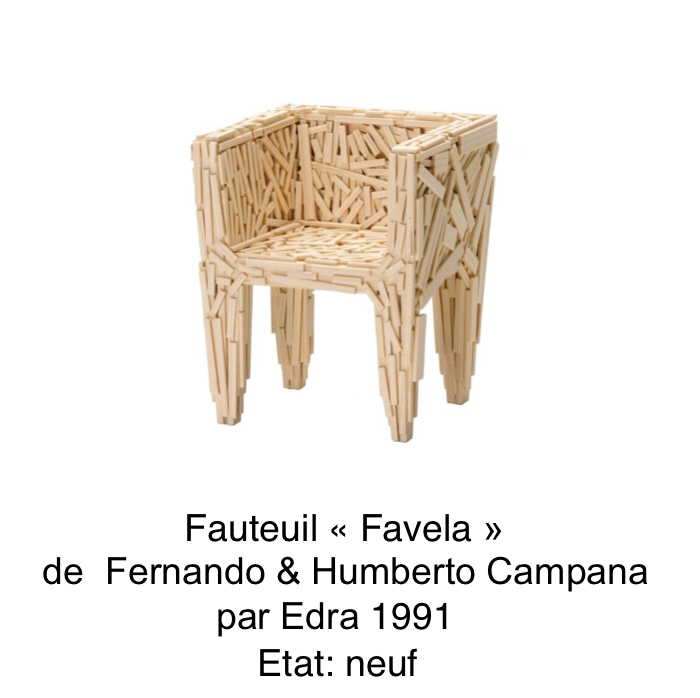Fauteuil
« Favela »
Fernando et Humberto Campana
Année 1991
Edra
Etat: Neuf
Prix sur demande

Description:
Armchair without internal structure, built with many strips of natural wood similar to those with which the « favelas » are built in Brazil. Its beauty lies in the naturalness of the materials and the apparent simplicity of the construction.The strips are nailed by hand in a random way, which makes each chair different from the other.The beauty of Favela lies in its natural materials, combined with the apparent simplicity of the construction.In reality, the chair is the result of a week’s work and a great deal of manual work with natural wood. Pine for indoor use, teak also for outdoor use.
Fauteuil sans structure interne, construit avec de nombreuses bandes de bois naturel similaires à ceux avec lesquels les « favelas » sont construites au Brésil. Sa beauté réside dans le naturel des matériaux et dans la simplicité apparente de la construction.Les bandes sont clouées à la main de manière aléatoire, ce qui rend chaque fauteuil différent de l’autre.La beauté de Favela réside dans ses matériaux naturels, unie à la simplicité apparente de la construction.En réalité, le fauteuil est le résultat d’une semaine de travail et d’une grande manualité de bois naturel. Pin pour un usage intérieur, teck également pour l’extérieur.
DÉTAILS TECHNIQUES :
Couleur : Naturel
Finition : Pin
Dimensions : L 67cm x H 74cm x P 62cm
Poids : 10 kg
Fernando et Humberto Campana:
Humberto Campana, lawyer and Fernando Campana, architect, have been working together in San Paolo since 1983 in the field of artistic design. They came to the forefront in 1989 with the exhibition of decorative objects with the provocative title « Gli inconfortabili » (« The uncomfortable ones »), destined to become, more than functional objects, political objects. To their radical vision contributes, the use of poor materials and industrial waste. The « handmade » represents in a poor country the possibility of social redemption. However, their goal is to find a Brazilian way to design, avoiding European colonization. In Italy, they took part in the exhibition « Viaggio in Italia » (« Journey to Italy »), at Abitare il Tempo in Verona in 1994 and in 1995 in the exhibition « Il Brasile fa anche design » (« Brazil also does design ») at the Brazilian consulate in Milan. In 1998, the Moma in New York dedicated an exhibition to them « Progetto 66 » with Ingo Maurer.
Humberto Campana, avocat et Fernando Campana, architecte, travaillent ensemble à San Paolo depuis 1983 dans le secteur du design artistique. Ils sont arrivés sur le devant de la scène en 1989 avec l’exposition d’objets de décoration au titre provocateur « Gli inconfortabili » (« Les inconfortables »), destinés à devenir, plus que des objets fonctionnels, des objets politiques. A leur vision radicale contribue, l’utilisation de matériaux pauvres et de déchets industriels. Le « fait main » représente dans un pays pauvre la possibilité de rachat social. Leur but est toutefois de trouver une voie brésilienne au design, en évitant la colonisation européenne. En Italie, ils ont participé à l’exposition « Viaggio in Italia » (« Voyage en Italie »), à Abitare il Tempo de Vérone en 1994 et en 1995 à l’exposition organisée dans le consulat brésilien de Milan « Il Brasile fa anche design » (« Le Brésil fait aussi du design »). En 1998, le Moma de New York leur a consacré une exposition « Progetto 66 » avec Ingo Maurer.
